The Layouts system in AtroCore allows you to customize the user interface for any entity by configuring how fields, panels, and relationships are displayed across different view types. Access layouts through Administration > Layouts.
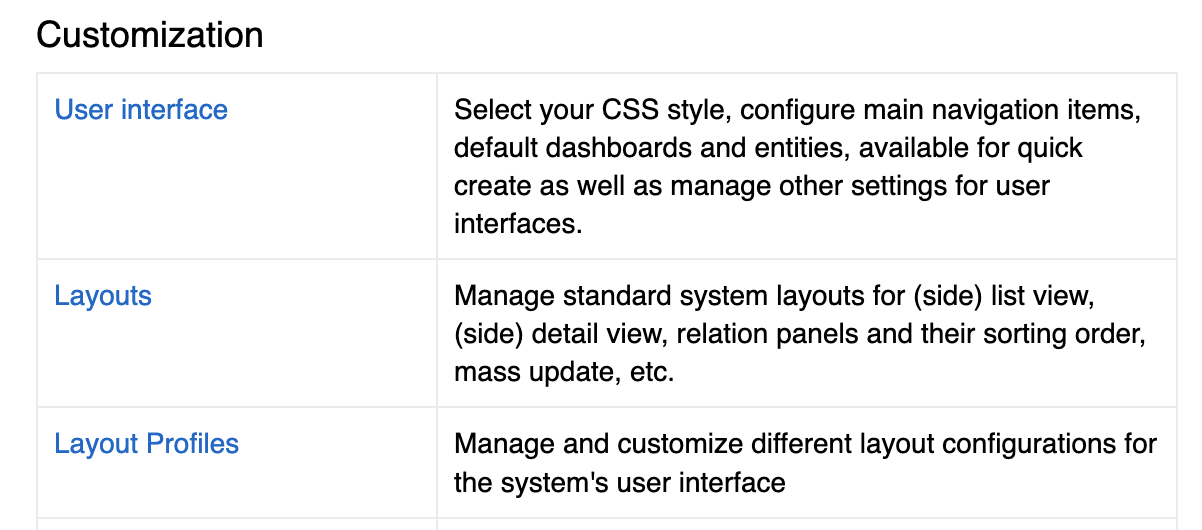
Overview
Layouts control the presentation of data in AtroCore's user interface. You can customize:
- Field positioning in forms and lists
- Panel organization in detail views
- Relationship displays in relation panels
- Navigation elements in side panels
Configuration Options
Layout Profile
Select the layout profile to customize. The Standard profile is the default configuration used system-wide.
Entity Selection
Choose from any available entity in your AtroCore installation, including:
- Core entities (Account, Contact, Product, etc.)
- Custom entities created through
Administration > Entities - Module-specific entities
View Types
List View
Configure which fields or attributes appear in list/table views and their order.
Adding more attributes may worsen performance, but this will not be noticeable for a couple of attributes.
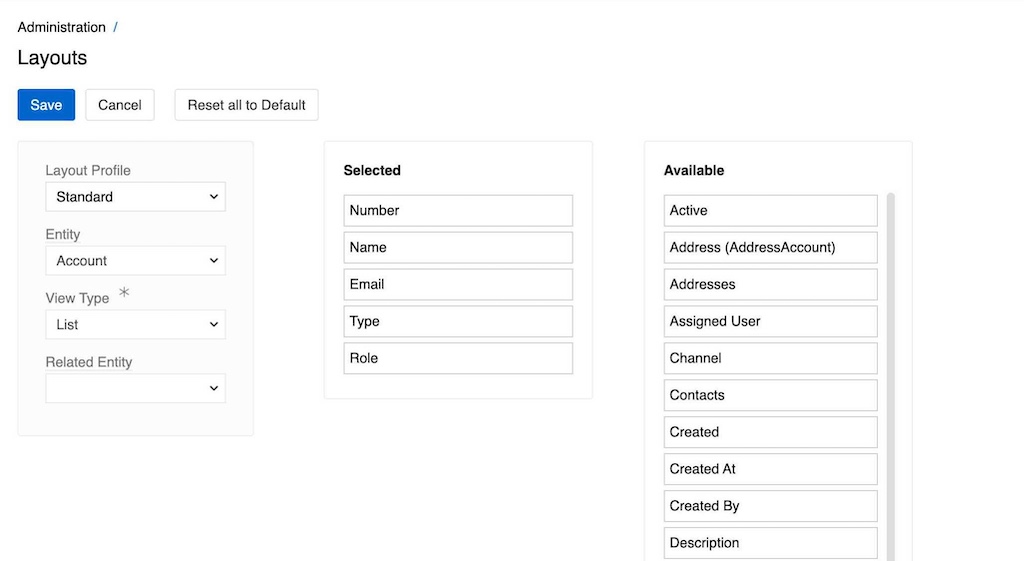
Configuration:
- Selected: Fields currently displayed in the list
- Available: Fields that can be added to the list
- Drag fields between sections to customize
- Pressing the cross next to a selected field or attribute will deselect it.
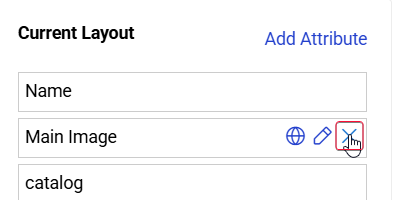

You can also access list view configuration directly from an entity's list view. Hover over the upper right corner of the list table to reveal the configuration button.
Details View
Design form layouts using a visual panel-based editor.
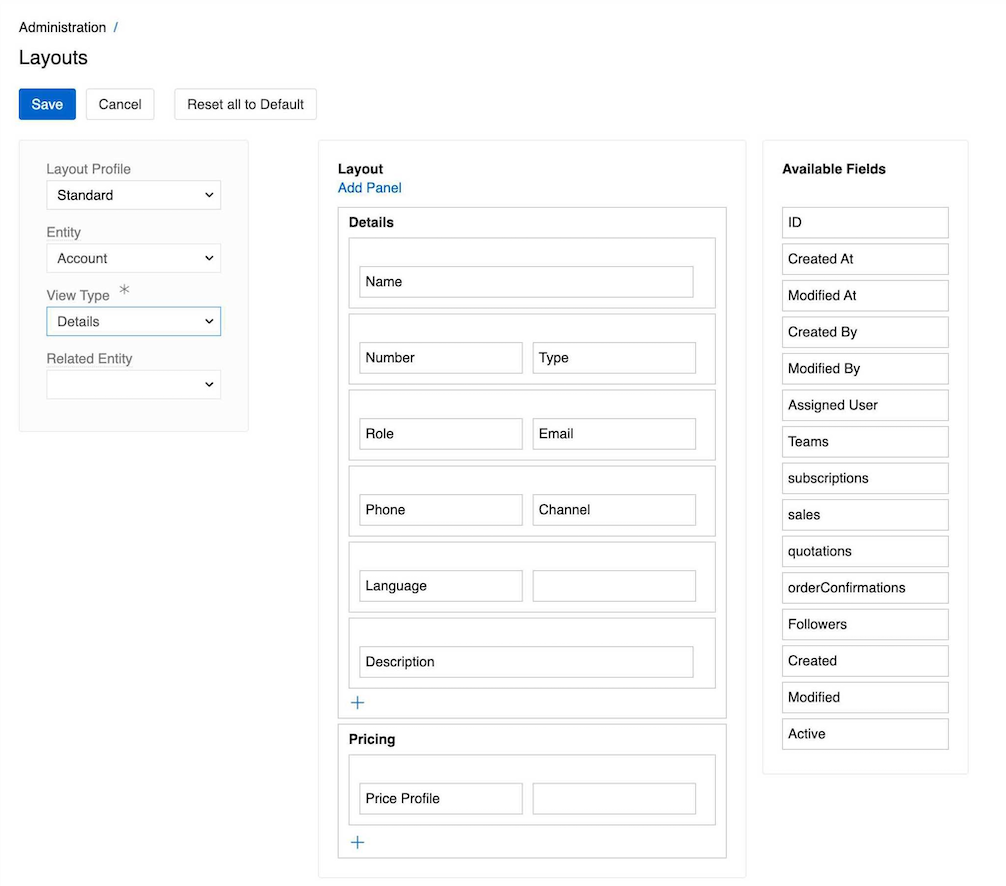
Configuration:
- Selected: Fields currently displayed in the form
- Available: All entity fields except Multiple Link fields (which are usually shown as separate panels)
- Drag fields between sections to customize
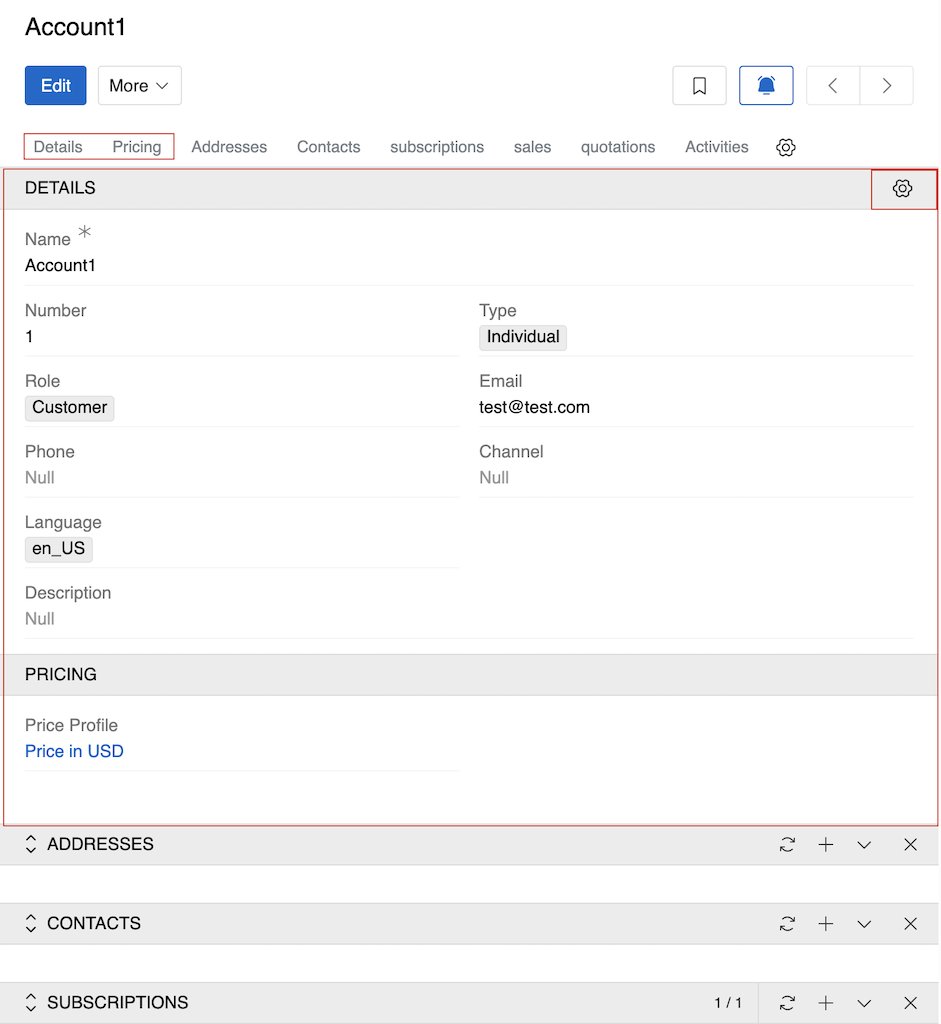
For field and panel management, see Field Management and Panel Management sections.
You can also access detail view configuration directly from an entity's detail view. Hover over the upper right corner of the first panel to reveal the configuration button.
Relations View
Control which relationships appear in detail views and their order.
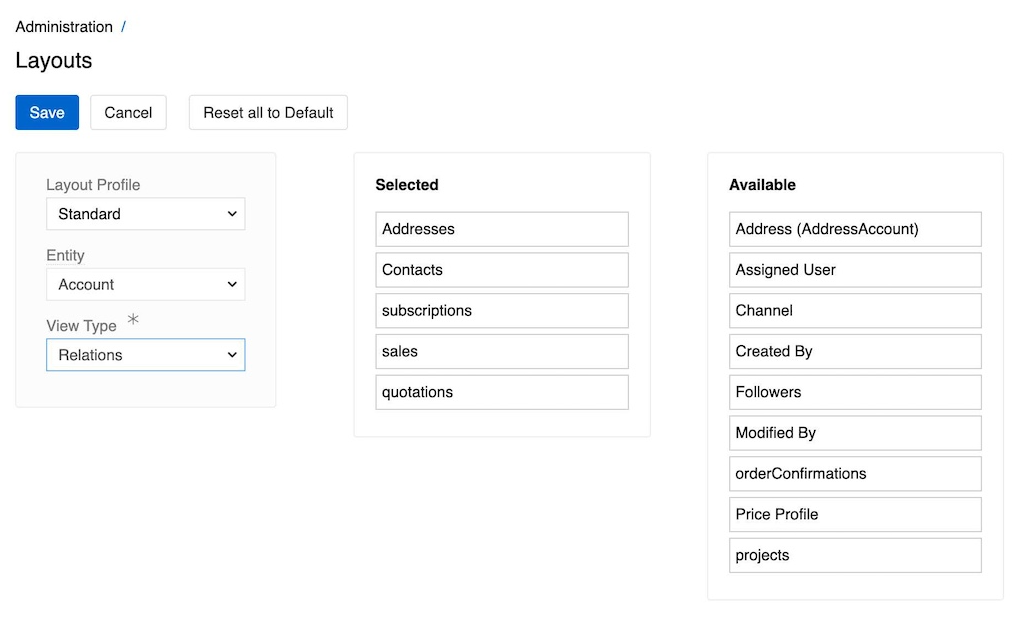
Configuration:
- Selected: Relationships displayed in the entity's detail view
- Available: All possible relationships for the entity
- Relationships appear as separate tabs/panels in the detail view
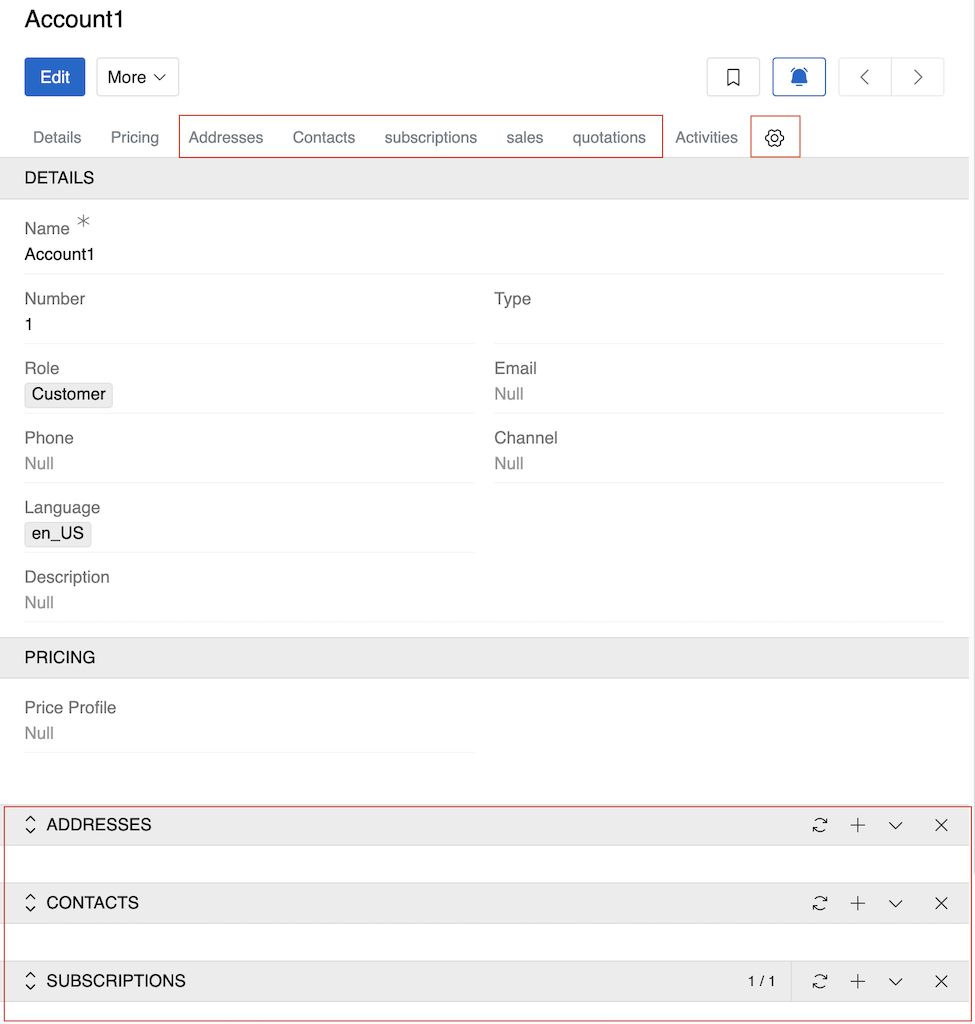
You can also access relations view configuration directly from an entity's detail view. The configuration button is found at the end of the panel navigation toolbar.
The Activities panel appears last in the detail view if enabled for the entity. Its position is fixed and cannot be changed in the layout.
Side View Panels
Configure navigation and quick-access panels that appear on the left or right side of the interface.
Left Side View: Configure the entity-specific left sidebar
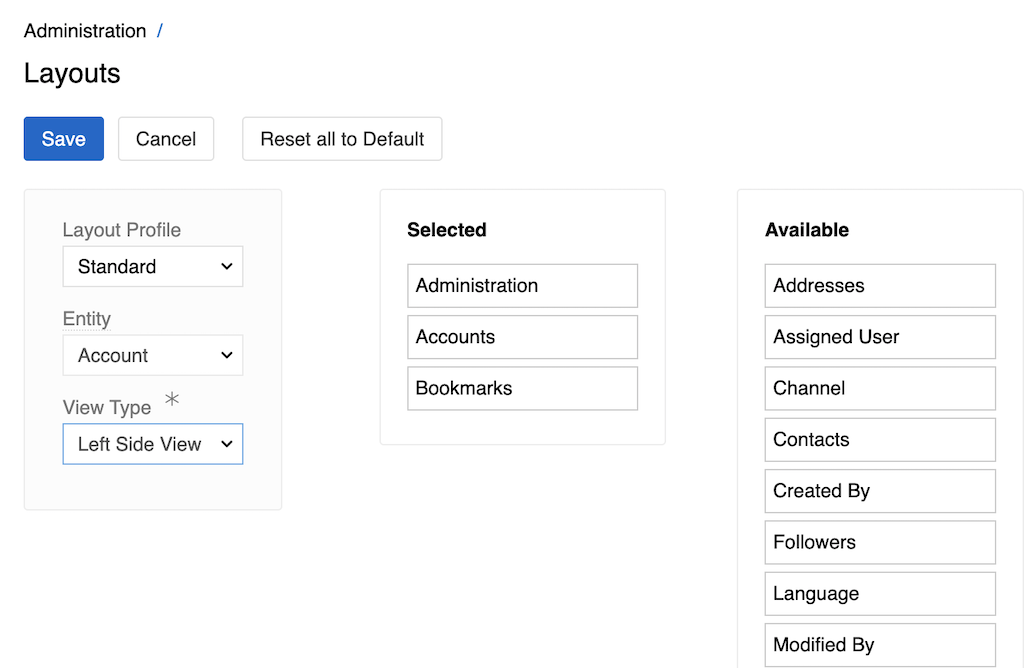
The left sidebar appears the same for both List view and Detail view. By default, it shows the selected entity itself and bookmarks. Available fields include the entity itself, Bookmarks, and all fields of type Link or Multiple Link.
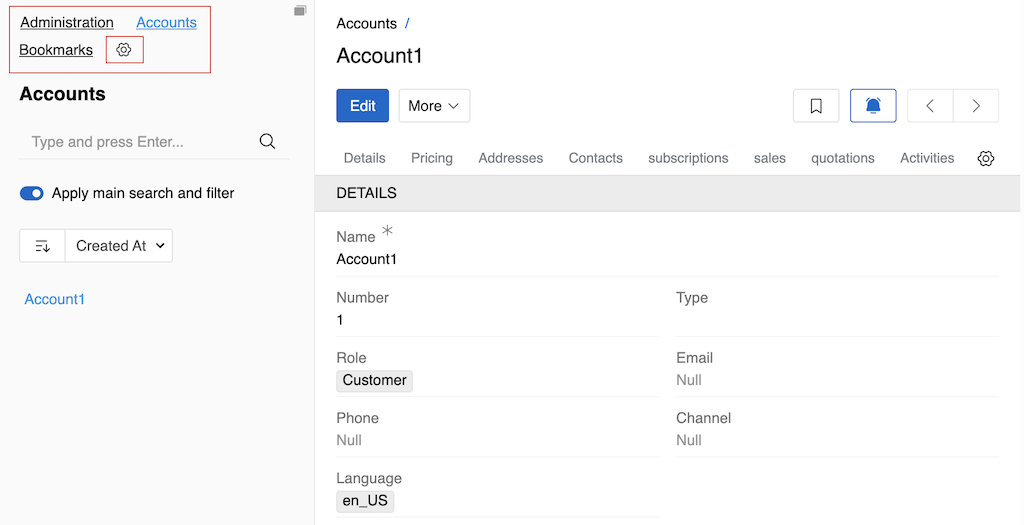
To learn how search works in the left sidebar, see Left Sidebar Search.
You can also access Left Side View configuration directly from an entity's list or detail view. Hover over the top of the left sidebar to reveal the configuration button.
Right Side View: Configure the content of the Summary tab in the right sidebar of the selected entity's detail view
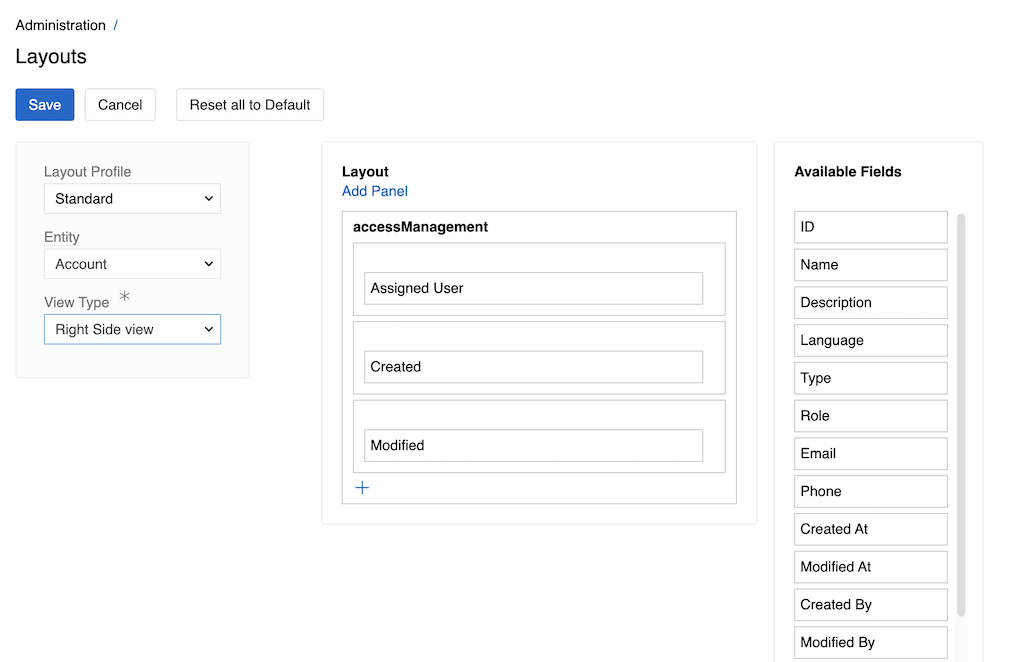
The Right Side View allows you to customize what information appears in the Summary tab of the right sidebar when viewing entity details. Available fields include all entity fields and some additional system fields.
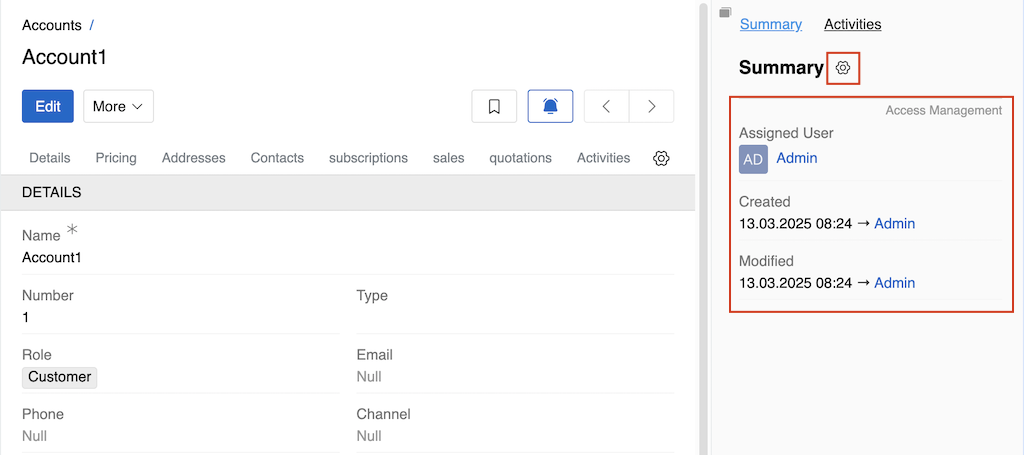
You can also access the Right Side View configuration directly from an entity's detail view. Hover over the Summary title to reveal the configuration button.
Working with Layouts
Field Management
Basic Operations:
- Adding Fields: Drag from "Available Fields" to the desired location
- Removing Fields: Drag from layout back to "Available Fields", or click the cross next to a selected field or attribute
- Reordering: Drag fields within the layout to new positions
Panel-Based Layouts (Details View, Right Side View): For layouts with panels, you work with placeholder rows and cells:
Setting Up Placeholders:
- Click the + button at the left bottom corner of a panel to add a placeholder row
- Each row contains two cells for two-column layout
- Fields can only be added to existing placeholder cells
Managing Rows and Cells:
- Add fields: Drag fields from "Available Fields" into empty cells
- Remove fields: Click the X button in a cell to clear the field (cell remains empty)
- Delete cells: After removing a field, click the - button to delete the cell completely
- Delete entire row: Hover over the row and click the X button in the upper right corner
- Delete individual cell: Hover over a cell and click the - (minus) button at the right end
- Reorder rows: Drag and drop rows to rearrange their order
Layout Behavior:
- Switch to single column: Deleting one cell causes the remaining cell to automatically expand to occupy the full row width
- Partial width fields: Rows with one empty cell are saved and display the field in half-width (left or right part)
- Empty rows: Rows with both empty cells are not saved
Panel Management
- Creating Panels: Use "Add Panel" to create logical field groupings
- Editing Panels: Hover over a panel to reveal the pencil button for editing panel name and style
- Deleting Panels: Hover over a panel to reveal the X button for deletion
- Reordering Panels: Drag and drop panels to rearrange their order in the layout
Layout Actions
- Save: Apply your layout changes
- Cancel: Discard unsaved changes
- Reset Layout: Restore the current view to default settings
- Reset all to Default: Restore all views for the entity to default
Related Entities
For entities with relationships, select a Related Entity to configure how that relationship's data appears when viewing from the parent entity.
Small List View Configuration: The Related Entity setting allows you to configure the so-called Small List View - how the selected entity panel will be shown in the related entity's detail view. This is particularly useful for customizing how related data appears in panels. For more information about Small List View, see Understanding UI - Small List View.
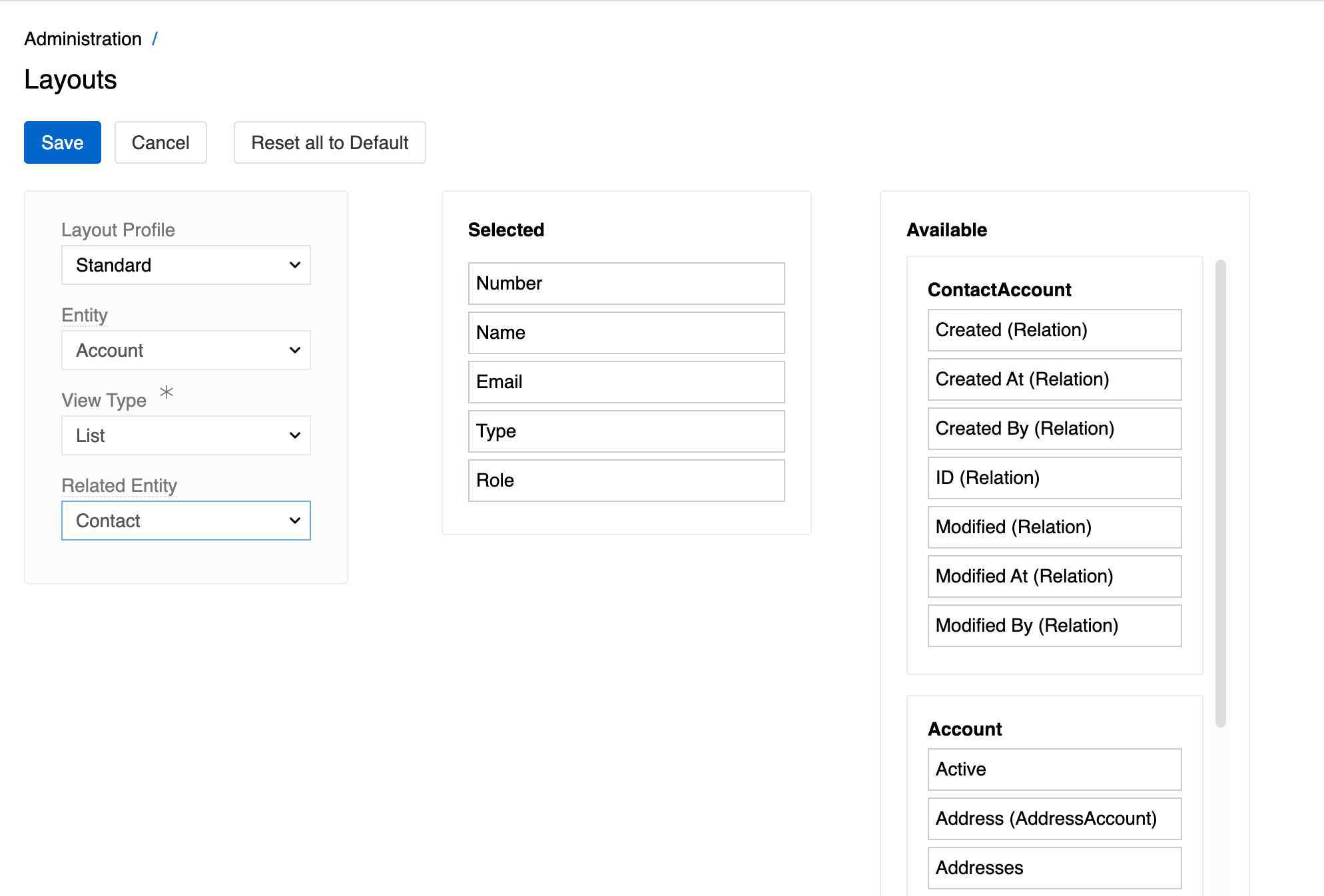
Small Detail View Configuration: The Related Entity setting allows you to configure the Small Detail View - how the detail form will appear when opened from a panel in the related entity for view, creation, or editing. By default, it uses the same layout as the basic Details view, but you can customize it specifically for the related entity context.
For more information about Small Detail View, see Understanding UI - Quick Detail View (Small Detail View).
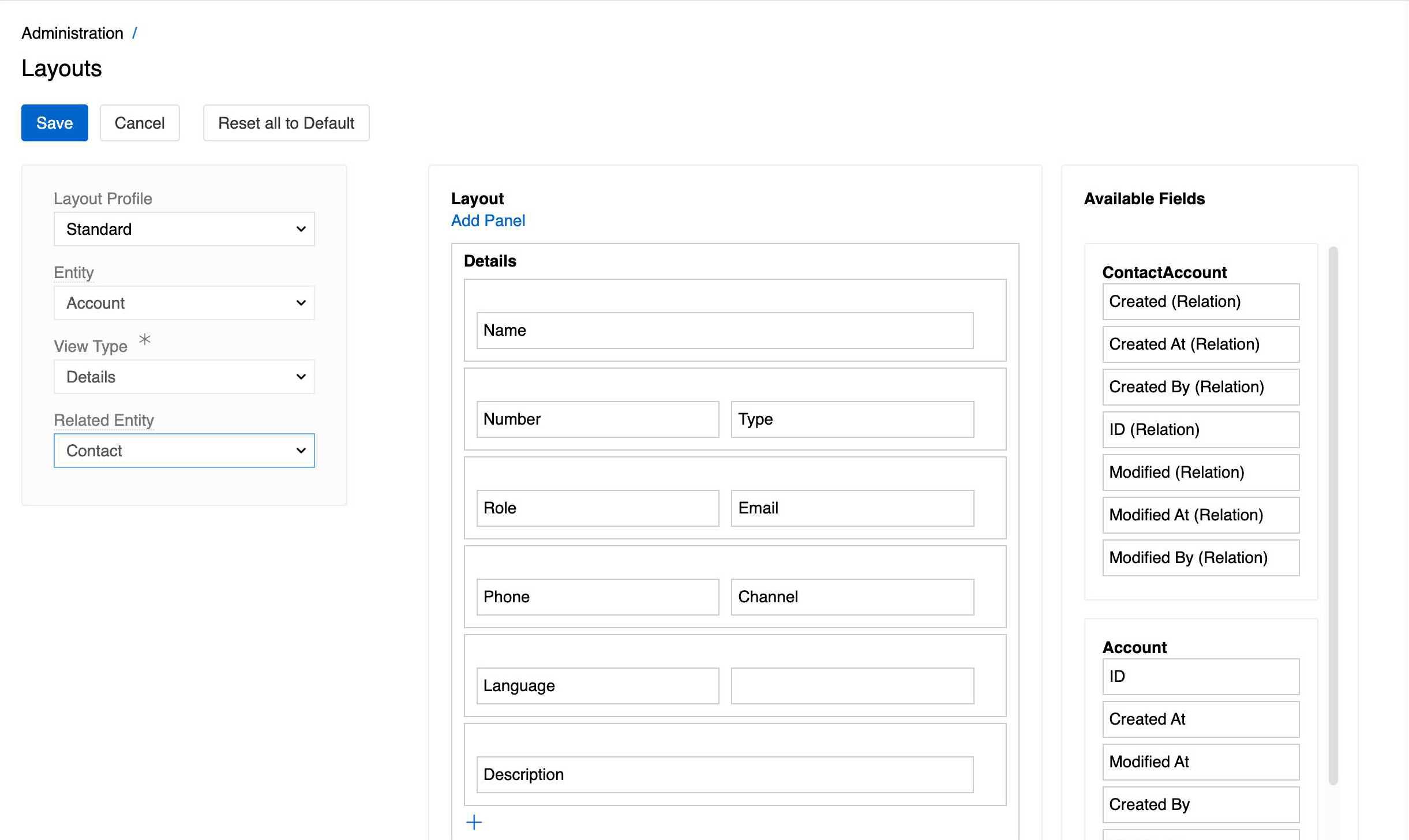
Examples: Account and Contact Relationship The screenshots above demonstrate configuration for both List and Detail views when Account and Contact are related entities:
- Contact has a field
Contact.accountswhich appears as a panel on the Contact record detail view - By default, these panels contain the same fields as the basic List/Detail views of Account
- With Related Entity configuration, you can customize both the Small List View and Small Detail View specifically for Contact
Many-to-Many vs One-to-Many Relationships:
- Many-to-Many (like Account-Contact): The system creates an additional relation entity (e.g.,
ContactAccount) with its own fields that are also available for layout configuration in both List and Detail views - One-to-Many (like Sale-Account): Only fields of the main entity (Account) are available for customization
For more information about relationship types and their configuration, see Fields and Relations.
Layout Profiles
Layout Profiles allow you to create different interface configurations for different user groups or purposes. While the Standard profile is used by default, you can create additional profiles through Administration > Layout Profiles.
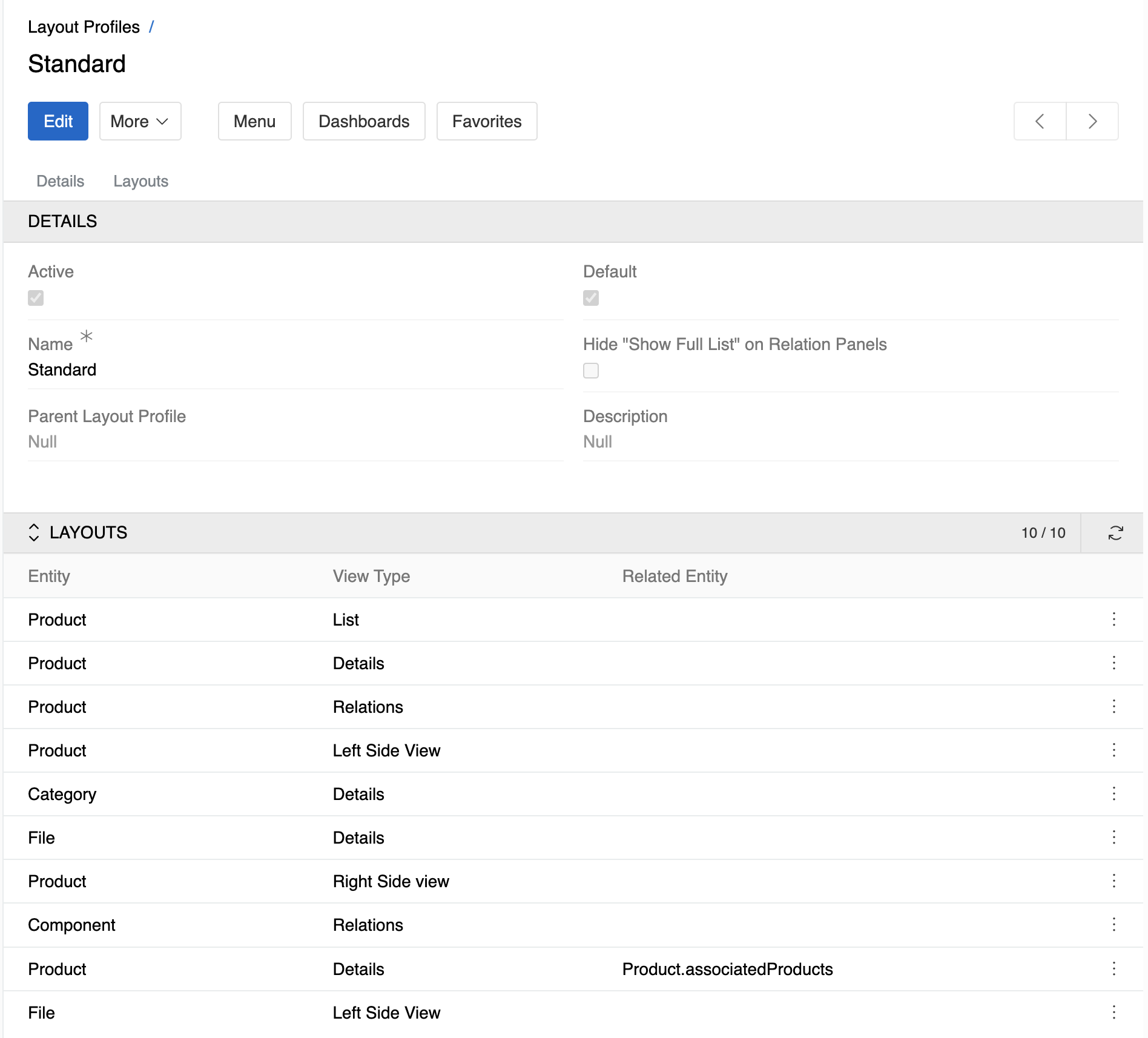
Profile Details:
- Active Status: Toggle whether the profile is currently active
- Default Profile: Mark as the system-wide default configuration
- Name: Set a descriptive name for the profile (required field)
- Parent Profile: Inherit settings from another profile (optional)
- Description: Add explanatory text about the profile's purpose
- Hide "Show Full List" on Relation Panels: Control visibility of the full list option
Associated Layouts: The profile displays all configured layouts organized by entity and view type.
Best Practices
Field Organization
- Group related fields into logical panels (e.g., "Contact Information", "Pricing", "Technical Details")
- Place important fields in the first panel and towards the top
- Use two-column layouts efficiently to maximize screen space
- Always include required fields to ensure users can save records and avoid validation errors caused by hidden required fields
Panel Design
- Create descriptive panel names that clearly indicate their purpose
- Limit panels to 8-10 fields to maintain usability
- Consider workflow when organizing field order
Relationship Management
- Prioritize frequently-accessed relationships in the Selected list
- Consider user workflow when ordering relationship tabs
- Remove unused relationships to reduce interface complexity
Notes
- Layout changes apply to all users using the selected Layout Profile
- Changes take effect immediately after saving
- Custom fields created through
Administration > Entitiesautomatically appear in Available Fields - In a multilingual configuration, fields for additional languages are automatically added to layouts and appear directly after the main language field. Their placement cannot be customized
After making layout changes, refresh your browser page to ensure the changes are properly displayed and avoid any cache-related issues